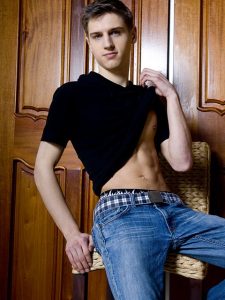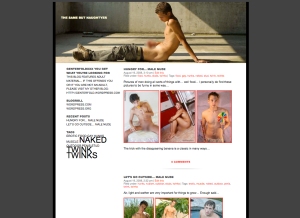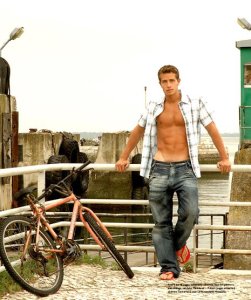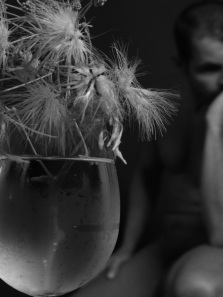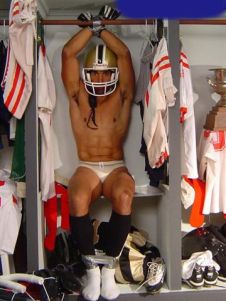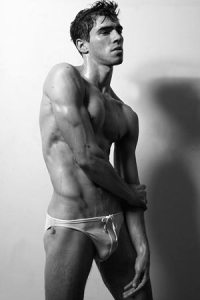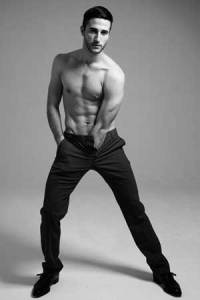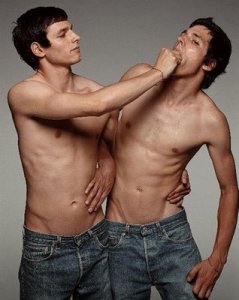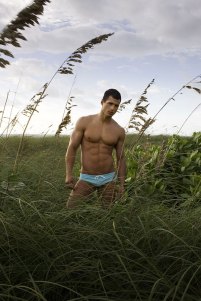Okay, if you are into twinks, this model certainly will rock your world… It’s Josh Jenson from Randy Blue…
He’s got a smooth body, a nice fresh face and some sort of charisma hard to place…
Filed under: Black and White, Muscle, Photograpy, Twink | Tags: adult, blog, Twinks
I do try hard to keep this blog decent and rather artistic. Yet, some people asked me if I couldn’t upload juicyer pictures. Sorry to say so, but on this blog I won’t… So, I created another blog: http://genterfoldxxx.wordpress.com.
Genterfoldxxx features the better pictures of internet-porn. So it’s not just a bloke masturbating or something, I always try to find the more “nicer” pictures. The new blog will probably not be visible in the tags of wordpress but then again, people that are looking for these pictures won’t bother with tags.
At this moment there aren’t many posts, but because it’s online from today more will follow in the days ahead.
Filed under: Actors, Black and White | Tags: actor, photography, River Phoenix
River Phoenix (August 23, 1970 – October 31, 1993) has played a role in some of my all time favorite movies: Stand by me, The mosquito coast, Indiana Jones and the last crusade, I love you to death and of course My own private Idaho.
One can only dream of the other movies he could have made. “I try to lie as much as I can when I’m interviewed. It’s reverse psychology. I figure if you lie, they’ll print the truth.”
“We are taught to consume. And that’s what we do. But if we realized that there really is no reason to consume, that it’s just a mind set, that it’s just an addiction, then we wouldn’t be out there stepping on people’s hands climbing the corporate ladder of success.”
Filed under: Art, Black and White, Muscle, Photograpy, Twink | Tags: Art, composition, focal point, photography
In our previous post about this subject we talked about “the heart and the brain of a picture”… let’s go a bit further this time.
2 prop or not 2 prop
That is definitly the question. Most photographers love to bring in certain items to a picture for several reasons: to make it more interesting, to create a certain atmosphere or even to promote a specific product. The question that rises when introducing a prop is very simple yet brutal in it’s core: what is most important in your picture? Do you really need the prop your introducing or is it nothing more than scenery? Do you need the model or is he just there to make the prop more interesting?
When you got this question answered only two possibilities remain: your model is more important than your prop or the other way around. Sometimes photographers will state that both are equally important. I’m sorry but this is impossible. If you introduce a guitar because the person is playing the guitar, the guitar is more important than the player because it is the guitar that tells us more about the person and not the other way around. When you introduce a guitar because you want to make clear that person has one, than the person rules over the guitar.
Man over Machine
There is something like a focal point… sounds pretty out there but trust me. The focal point is the main attraction of you picture, the rest becomes less important and sometimes even vague. You can acquire this by using all sorts of techniques: the rule of lines, by blurring out the rest, by centering the focus point, by adjusting your shutterspeed (i.e. a man standing in front of traffic), using more light or less light on your main character and even by colouring certain parts of a black&white picture.
When the male model posing is more important than your object you should put the focus on your model, this is probably too logic to mention. But beware: it’s not because one is more important than the other that the other one should be unnoticable.
Master and slave characters
Okay, this sounds pretty kinky… When you have more than one person in your frame you may want to consider to put one person in front of the other, not physically of course. It’s important that the other person is not considered as a prop but more as a slave character. It’s perfectly possible that both characters are considered ecqually important, but in this case one enhances the other. The rules to create these kind of pictures are not much different than the prop-technique. Let’s take the following picture as an example.
In the following picture the photographer (Z. Martz) has used different techniques to create a master/slave character composition. First of all let’s take a look at the lines. The most dominant lines are the vertical lines on the bedsheet in combination with the vertical lines in the background (doorway, legs). You may be surprised but the slave character in this picture is actually the boy laying down. Why? For several reasons. The boy entering the room is determining the composition of the picture: suddenly it’s not just a boy laying in bed. The light on the person standing is stronger and the boy laying down is somewhat blurred away.
Filed under: Muscle, Twink | Tags: feet, fetish, furries, leather, Muscle, rope, sailor, tied
It’s been awhile but I’m back with a vengeance. This post isn’t really about photography to be honest but it has some pictures in it so it’s certainly worth a place on my blog. It’s about fetishes :p so let’s go kinky
The strange thing about fetishes is that some are considered normal and others are still taboo. If I would say that I simply love the eyes of my boyfriend people will not even consider this to be a fetish, but my oh my when I do love his armpits than i’m suddenly an armpit fetishist. In my opinion having a fetish that doens’t involve illegal activity is a relief and even healthy.
Filed under: Art, Muscle, Photograpy | Tags: artists, fetish, Kinky, Muscle, Nicolas Wagner, photography
Nicolas Wagner is a famous photographer who has worked for many international clients.
I simply love the way this artist tries out fresh angles. His pictures are daring, sometimes kinky but always honest and original.
He worked for l’oreal, sony music, tom ford and many, many others…
Filed under: Muscle, Photograpy | Tags: brothers, Gay, hunks, identical, Muscle, twin, twins
If you like gorgeous men than you must love gorgeous twins…
There is almost a forbidden desire hanging around them…
Filed under: Art, Muscle, Photograpy, Twink | Tags: Harry Philpott, models, Tom Philpott
Meet Harry Philpott and his brother Tom Philpott.
Each brother has his unique style… Harry being more muscular and Tom acting like the twink he is.
I do like the innocent expressions and the freshness they both impale.
If there is any subject I’m really interested in than it must be “scene composition” or “how to tell an entire story with just one shot”. It is the difference between a normal picture and art, it takes the saying “a picture is worth a thousand words” literally.
There is one word that will dominate this post: Creativity. Some of you will see this as a positive thing while others will say that they don’t have it, can not be or even never were. Luckily for them this is nothing more than a pile of omnivoric faeces. In my opinion you can compare creativity with a muscle. There is one difference however, this particular muscle was fully trained in our childhood, but like every muscle it tends to go weak if we don’t use it enough. The good thing is that you haven’t lost it, it’s just hanging there waiting to be used and trained again.
A good way to train your creativity: when you go to bed just take some time to think. Create a story starting with a single, basic character: a child, man or woman. How old is this person, where does he or she lives, how does the environment infect this character, what is the context of her/his environment, can he or she change it and how. Dare to go further and further each time you look towards that fictional figure in your head. When you do this on a regular base you will discover that the way the character develops becomes more and more interesting each time. Creativity is the base of a good picture, make this your motto.
The heart of your picture
Okay, let me tell you a secret. When you create a scene within your picture it is vital that it enhances your picture, making it more interesting. How do you do this. Let’s take the following easy scenario. A young man is sitting in his appartement and it’s extremely hot. He feels an urge to dip his head in a bowl of water. Afterwards he takes a towel to dry his face and clean the floor of his appartement. We have three possible scenes and I do hope that you feel the same way when I say: the middle one is the most interesting. This is often the time when you take a three scene scenario. And that is the big secret. Easy isn’t it. In movies the last scene or climax is extremely important but in photography the middle scene tells you everything. It suggests a past but also creates a suggestion towards a near future.
The second picture, and the fact that it has also water in it, is quite similar. It suggest a man diving, it doesn’t show us how he jumps and eventually dives in the water but we know it has and will happen.
The brain of a picture
The two previous pictures are created within a certain situation. But sometimes the fact that they have done it is not the most important element of the picture. Motivation, or the “why” they are doing it is also a key ingrediënt in scene composition.
The intention of this pictures shifts from the physical to the emotional. We don’t care how this person got up there (okay, to be honest I did but somehow I know the answer will be disapointing). The question that enchants this picture is the question “why”. Why did he get up there? The fascinating thing when using this technique, to tell a story behind a picture, is that people will have different opinions, therefore overlapping the distance between spectator and model.
Okay but how do you create this kind of atmosphere as a photographer? Easy, you place your model in an unusual environment, you make him do something strange in an everyday situation, you place the focal point of your picture on your character in a way that it differentiates him or you just try to be, well creative.
Sometimes you can combine the elements above in your pictures. For example: if you take a picture of a gangster holding a knife, the situation is physical. We care less about the reason behind it and are convinced that he will use it to kill somebody. When you give the knife to a businessman, the emotional part takes over, people will want to know what he is going to do with it. If you give it to a baby, the emotional gets twingled with the physical, what is going to happen and where did it come from.
Filed under: Art, Muscle, Photograpy | Tags: Art, lines, male, Muscle, photography
Previously we talked about horizontal and vertical lines in male photography, but surprise-surprise there are also other lines that are important: diagonal and curved lines.
In stead of taking the same model and placing it on different backgrounds like we did before, this time we are going to discuss one picture for each compositional lining structure.
Diagonal lines
Diagonal lines create a natural flow within the image and they generally draw the eye of the beholder through the photograph. You can add points of interest in your picture when you intersect these lines with other lines, be carefull though using this technique can make your picture look chaotic. Diagonal lines often give pictures depth by suggesting a certain perspective or add a sense of actio to an image adding a dynamic look and feel.
Different studies have been done into how people view images and many of them say that a natural way into an image is by traveling left to right and so a diagonal line starting at the bottom left and moving to the top right of an image can be quite useful and natural.
Curved lines
Curved lines suggest a sense of elegance, sensuality and a serene sense of balance. Curves can have any shape wanted, any form of a winding line can be used. Some examples include rivers, streams, paths and of course the male body.
The second picture illustrates that, as with any lines, curved lines can act as a baseline or secondary line to create a certain dynamic to your picture.




